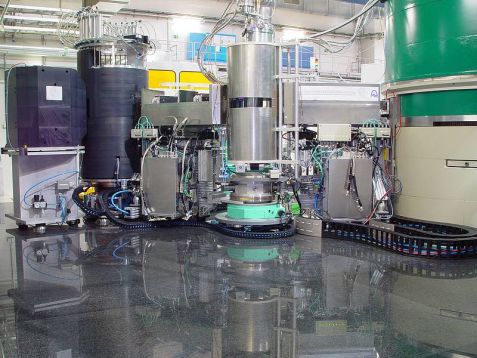MLZ is a cooperation between:
 > Technische Universität München
> Technische Universität München > Helmholtz-Zentrum Hereon
> Helmholtz-Zentrum Hereon
 > Forschungszentrum Jülich
> Forschungszentrum Jülich
MLZ is a member of:
 > LENS
> LENS > ERF-AISBL
> ERF-AISBL
MLZ on social media:

MLZ (eng)
Lichtenbergstr.1
85748 Garching
26.10.2012
Vibrations at absolute zero
Neutron experiments show, that the theoretical concept of superfluids by Nobel Prize winner Lev Landau must be corrected in details.

For their high-precision measurements of superfluid helium, the researchers used the instrument TRISP at the Research Neutron Source Heinz Maier-Leibnitz (FRM II), which has a unique energy resolution.
At temperatures close to absolute zero, matter changes its properties. Metals such as lead or mercury, which conduct electricity poorly at room temperatures, become superconductors and conduct electricity without any resistance. Similarly, the noble gas helium, which is liquid at a temperature of 4 Kelvin, at 2.2 Kelvin turns into a new physical state and gets superfluid. Superfluid Helium loses any internal friction, resulting in unusual phenomena: For example, when slowly rotating a container, the helium will not rotate, but will remain motionless in the container.
The pioneering work on superfluids was made by the Russian physicist Lev Landau. In the forties of the last century, Landau worked with great intensity on the development of a theoretical concept of superfluids. He formulated a theory on the basis of quantum mechanics, for which he received the Nobel Prize for physics in 1962. Lev Landau explained the properties of helium at extremely low temperatures by weakly interacting lattice vibrations.
Scientists from the Research Neutron Source Heinz Maier-Leibnitz (FRM II) and the Max Planck Institute for Solid State Physics together with colleagues from France and USA have now found, that the lattice vibrations of superfluid helium have a different temperature dependence than described by Landau. For their high-precision experiments the physicists used the instrument TRISP at the Research Neutron Source Heinz Maier-Leibnitz, which has a unique energy resolution. Theoretical recalculations confirmed the experimental results.
“Our results are important for scientists who deal with the physics close to absolute zero”, says Thomas Keller, scientist at the Research Neutron Source Heinz Maier-Leibnitz. With superfluid helium, researchers can observe the behavior of a so-called Bose-Einstein condensate, an important model for a system of particles, which at very low temperatures are predominantly in the same quantum state.
Original publication
Roton-Phonon Interactions in Superfluid 4He
B. Fåk, T. Keller, M. E. Zhitomirsky, and A. L. Chernyshev
Phys. Rev. Lett. 109,
155305 (2012)
DOI: 10.1103/PhysRevLett.109.155305
Contact
Dr. Thomas Keller,
Research Neutron Source Heinz Maier-Leibnitz (FRM II),
Tel. ++49 89 289 12164,
E-Mail: thomas.keller@frm2.tum.de
Press contact
Petra, Riedel,
Research Neutron Source Heinz Maier-Leibnitz (FRM II),
Tel. ++49 89 289 12164,
E-Mail: presse@frm2.tum.de“Linktext hier”: presse@frm2.tum.de
MLZ is a cooperation between:
 > Technische Universität München
> Technische Universität München > Helmholtz-Zentrum Hereon
> Helmholtz-Zentrum Hereon
 > Forschungszentrum Jülich
> Forschungszentrum Jülich
MLZ is a member of:
 > LENS
> LENS > ERF-AISBL
> ERF-AISBL
MLZ on social media:


